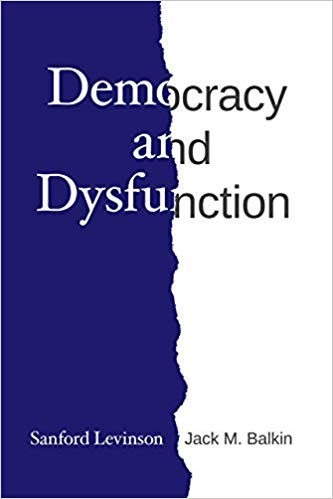Balkinization
an unanticipated consequence of
Jack M. Balkin
Balkinization Symposiums: A Continuing List
E-mail:
Jack Balkin:
jackbalkin at yahoo.com
Bruce Ackerman
bruce.ackerman at yale.edu
Ian Ayres
ian.ayres at yale.edu
Corey Brettschneider
corey_brettschneider at brown.edu
Mary Dudziak
mary.l.dudziak at emory.edu
Joey Fishkin
joey.fishkin at gmail.com
Heather Gerken heather.gerken at yale.edu
Abbe Gluck abbe.gluck at yale.edu
Mark Graber
mgraber at law.umaryland.edu
Stephen Griffin
sgriffin at tulane.edu
Jonathan Hafetz
jonathan.hafetz at shu.edu
Jeremy Kessler
jkessler at law.columbia.edu
Andrew Koppelman
akoppelman at law.northwestern.edu
Marty Lederman
msl46 at law.georgetown.edu
Sanford Levinson
slevinson at law.utexas.edu
David Luban
david.luban at gmail.com
Gerard Magliocca
gmaglioc at iupui.edu
Jason Mazzone
mazzonej at illinois.edu
Linda McClain
lmcclain at bu.edu
John Mikhail
mikhail at law.georgetown.edu
Frank Pasquale
pasquale.frank at gmail.com
Nate Persily
npersily at gmail.com
Michael Stokes Paulsen
michaelstokespaulsen at gmail.com
Deborah Pearlstein
dpearlst at yu.edu
Rick Pildes
rick.pildes at nyu.edu
David Pozen
dpozen at law.columbia.edu
Richard Primus
raprimus at umich.edu
K. Sabeel Rahmansabeel.rahman at brooklaw.edu
Alice Ristroph
alice.ristroph at shu.edu
Neil Siegel
siegel at law.duke.edu
David Super
david.super at law.georgetown.edu
Brian Tamanaha
btamanaha at wulaw.wustl.edu
Nelson Tebbe
nelson.tebbe at brooklaw.edu
Mark Tushnet
mtushnet at law.harvard.edu
Adam Winkler
winkler at ucla.edu
Compendium of posts on Hobby Lobby and related cases
The Anti-Torture Memos: Balkinization Posts on Torture, Interrogation, Detention, War Powers, and OLC
The Anti-Torture Memos (arranged by topic)
Recent Posts
Just A Few Blogs
ACS Blog
Alas, a Blog
Althouse
Arts and Letters Daily
Atrios (Eschaton)
Bill of Health
Buzzflash.com
Buzz Machine
Cato at Liberty
Juan Cole (Informed Comment)
Concurring Opinions
The Constitution in 2020
Corrente
Crooked Timber
Daily Howler
Daily Kos
Dana Boyd
Brad DeLong
Digby (Hullabaloo)
Discriminations
Daniel Drezner
Kevin Drum (Mother Jones)
Electrolite
En Banc
Eunomia (Daniel Larison)
Fafblog
Michael Froomkin (Discourse.net)
GovLab (Beth Noveck)
Rick Hasen (Election Law)
History News Network
How Appealing
Ignatz (Sam Heldman)
The Importance of (Ernie Miller)
Infolaw
Instapundit
International Economic Law and Policy Blog
IntLawGrrls
Jacob Levy
Jesus' General
Jurisdynamics
The Kitchen Cabinet
Mark Kleiman
Law Blog Central
Larry Lessig
Lawyers, Guns and Money
Liberal Oasis
Brian Leiter's Law School Reports
The Leiter Reports
Marginal Revolution
Megan McArdle
Memeorandum
Metafilter
Mirror of Justice
The New Republic
Newseum
No More Mister Nice Blog
Brendan Nyhan
Opinio Juris
Orcinus
The Originalism Blog
Pandagon
Passport (Foreign Policy)
Overcoming Bias
Political Animal (Washington Monthly)
Political Theory Daily Review
Political Wire (Taegan Goddard)
The Poor Man
Virginia Postrel
Prawfsblawg
Public Reason
Jonathan Rauch
Raw Story
Redstate
ReligiousLeftLaw.com
Reporters Committee For Freedom of the Press
Reproductive Rights Blog
Rothman's Roadmap to the Right of Publicity
SCOTUS Blog
Seeing the Forest
Clay Shirky
The Shifted Librarian
The Situationist
Larry Solum (Legal Theory)
Andrew Sullivan
Talking Points Memo
Talk Left
Tapped
Tbogg
TechPresident
The Paper Chase (Jurist)
Tom Paine
Tom Tomorrow (This Modern World)
Eve Tushnet
Uggabugga
University of Chicago Law School Faculty Blog
Unqualified Offerings
The Volokh Conspiracy
War and Piece (Laura Rozen)
Wampum
Oliver Willis
Wonkette
Written Description
Matthew Yglesias
Yin
Your Choice of Feeds
1. XML
powered by
2. Atom Feed
3. RSS 2.0
JB
Roe v. Wade as a Lightning Rod
The Times, like most newspapers, gives you only about 700 words to make your argument, so I thought I’d add a few additional explanations about three important points that the op-ed raises. The first is how judicial review affects political coallitions, the second is how the Supreme Court diverts political heat onto itself, and the third is the special place of religion as a divisive issue in politics. These three ideas are analytically distinct, but they all apply to Roe, and for lack of space, they all had to be explained together in the op-ed. I'd like to separate them out in this post.
1. Judicial Review and Party Coalitions. The basic idea that shifting policy agendas shifts party coalitions is nothing new. The classic explanation of how judicial review preserves or destroys party coalitions by shifting policy agendas was made by Mark Graber in his article "The Nonmajoritarian Difficulty," published in 1993, and the basic idea about how shifting policy agendas fractures political coalitions was explained by William H. Riker in his book The Art of Political Manipulation (1986). Both used the Supreme Court’s decision in Dred Scott v. Sandford as an example, and Graber showed how the same logic applied to Roe.
The basic idea is this: Through its exercise of judicial review, the Supreme Court can either keep party coalitions together or it can fracture them. Roe is an example of the former, Dred Scott is an example of the latter. Both involve striking down statutes, but the issue is not really whether the Court strikes down something or upholds it. It is whether the decision keeps the party system together or blows it apart. Roe helps keeps the contemporary party system together, Dred Scott blew the party system of its day apart.
Before Dred Scott, the Democratic Party was amazingly successful at winning the Presidency. It did so because it was a coalition of Southern Democrats who were devoted to the preservation and spread of slavery, and Northern Democrats, who cared less about the issue. Instead, they dealt with the question through a series of compromises. Democrats in the North instead pushed for the idea of popular sovereignty. Each state and, more importantly, each territory could decide for itself whether it wanted to be free or slave. Dred Scott made this position impossible, because it held that Congress could not ban slavery in the territories, and that slaveowners had the right to bring slaves into the territories. This split the Democratic Party in two, destroying its chances at winning the presidency. As a result, Abraham Lincoln won the White House. Unable to accept the Republican Party’s control, South Carolina seceded, beginning the Civil War.
From the standpoint of the Democrats, Dred Scott was a terrible blunder because the Supreme Court made it impossible to form a working majority within the Democratic Party. On the other hand, if you think that slavery would never have been resolved peacefully, it was probably better that the Court wreck the coalition and get on with the War. In the casebook that Paul Brest, Sandy Levinson, Akhil Amar, and I edit, we have this to say about the timing issue:
Another recent example of how Supreme Court decisions affect coalition formation is affirmative action. The Democratic party includes African Americans, Latinos and white liberals who strongly support affirmative action, and moderates who are iffy on affirmative action. In this case, its possible that by applying strict scrutiny to affirmative action programs, the conservative Justices in the Supreme Court are actually keeping some people in the Democratic Party, because they limit how far the left wing of the party can push for affirmative action. The logic is very similar to that in Roe, with the parties reversed. If Croson and Adarand were overruled, it might not work to the advantage of the Democrats.
But the issue on the table right now is not overturning those decisions; It is extending them by overruling Bakke. That shifts the political agenda in a different direction than overruling Croson and Adarand, because it means less affirmative action, not more. If Bakke were overturned, and Croson and Adarand applied to university admissions, you might get more movement toward the Democrats than movement away from them.
2. Judicial Review and the Supreme Court as Lightning Rod. A different idea in the piece is that the Supreme Court can act as a lightning rod, taking heat from the political process and onto itself. The best recent example of this would be Judge Richard Posner’s argument about the 2000 Election. Even if the decision in Bush v. Gore didn’t make much sense as a matter of legal argument, Posner argues, it had the beneficial effect of resolving the disputed election and preventing riots in the streets. If Posner is right on his facts, I think this is an excellent example of how the Supreme Court can act as a lightning rod. I’ve argued in a recent article that Posner is wrong on the facts; there were no riots in the streets, and there were unlikely to be riots in the streets. The Democrats did not suggest that they would take no prisoners if they lost. (Ironically the party that was most likely to threaten civil disorder if they lost was the Republican Party, and since they are the law and order party we know they would never do a thing like that. :-) ). Therefore, it was unnecessary for the Supreme Court to act as a lightning rod to resolve the election, and it should not have done so. Still, it is true that two years after the 2000 election the bitterness about the election is largely sublimated in the general public, so perhaps Posner is right, although I’ve also argued that the memory of the election may still come back to haunt the Bush Presidency, like Poe’s tell tale heart. Only time will tell.
3. Religion as a Coalition Busting Issue. The final point the piece makes is that certain types of issues tend to be coalition busting and diffusing them by shifting the grounds of political agendas helps working majorities form; by contrast, other issues are less threatening to coalition building and controversies are less problematic for democratic politics. Slavery was one such divisive, coalition busting issue. I tend to think that religion is another, at least in contemporary America. This is not an argument against the recognition of religious argument in the public sphere, which I support. Rather it is an argument for certain types of decisions about religious liberty that help religious and secular people inhabit the same political space and belong to the same political party. One interesting feature of American politics is that although religion has played a central role in the development of American values, the political parties have usually been quite polyglot. The Democrats, for example, contained both Southern Baptists and urban Catholics. One reason why I support some types of changes in the current doctrines of religious liberty and not others is because of how they affect the everyday practice of politics. I hope to say more about that later.
My op-ed on Roe and the Republican party's coalition appears in today's New York Times.
If one objects to Taney's opinion on the grounds that it hastened war, consider that a decision freeing Dred Scott would surely have generated intense opposition by the already secession-prone Southerners, who might not have waited until 1860-61 to attempt secession. Consider also that the North might not have won a war begun in 1857, especially because of its lack of military preparedness and the fact that its Commander-in-Chief would have been the feckless James Buchannan rather than Abraham Lincoln. Is this a good reason to support the result in Dred Scott--that it bought the North valuable time? Or is your view that justice, i.e., the repudiation of slavery, should be done (and, indeed, is required by the Constitution) though the heavens (or, at least, the Union) fall?
Posted
1:43 PM
by JB [link]
Burberry Chaussures
Burberry Chemises
Burberry Pas Cher
Burberry Sac Pas Cher
Seperti yang anda tahu, Windows 7 merupakan sistem operasi yang sangat populer saat ini. Anda perlu mengetahui bagaimana cara menginstal windows 7 dengan mudah. Selain itu, menyayangi laptop harus anda lakukan, berikut ini bagaimana cara merawat laptop. Gmail merupakan salah penyedia layanan email yang sangat populer saat ini. Beginilah cara membuat email baru di gmail dengan mudah. Sesudah anda mempunyai akun gmail, yang perlu anda lakukan selanjutnya adalah bagaimana cara mengirim email lewat gmail.
Sedikit informasi bagi anda yang membutuhkan web hosting, anda bisa mencoba Sanggarhost.com Web Hosting Gratis, Murah, Terbaik dan Berkualitas di Indonesia yang direkomendasikan oleh swordlessme.wordpress.com. Yang perlu anda ketahui dari Sanggarhost.com Web Hosting Gratis, Murah, Terbaik dan Berkualitas di Indonesia adalah menyediakan web hosting gratis yang mungkin anda butuhkan. Sedikit informasi juga mengenai salah satu blog yang cukup bermanfaat bagi anda, yaitu tugubangil.wordpress.com . Web hosting Sanggarhost.com Web Hosting Gratis, Murah, Terbaik dan Berkualitas di Indonesia
Mengingat informasi mengenai Sanggarhost.com Web Hosting Gratis, Murah, Terbaik dan Berkualitas di Indonesia sangatlah bermanfaat, anda perlu membaca reviewnya di bloggerkanak.blogspot.com dan juga mengenai isi postingannya di Sanggarhost.com Web Hosting Gratis, Murah, Terbaik dan Berkualitas di Indonesia . Blog pribadi lainnya yang saya gunakan adalah slayerising.blogspot.com yang membahas tentang bagaimana cara mengoptimalkan ram pada browser dengan mudah yang ditulis oleh nesabachip.blogspot.com
we wait for your next post ..
obat perangsang wanita
obat perangsang wanita
alat bantu sex
alat bantu sex
thanks for sharing.
Please visit Cara Kesehatan Kecantikan
Fitra rahim
voucher 1 juta
Fast fitra
Fitra inc
ismytea
Saya Sukai
Temanet
Fybernet
Read Tab
Kota Host
High ternet
Max5ever
Page Phone
Fitvill
Koleksiseo
Belajar Unity3D
Dunia Unity
Home Fage
fitrarahim
Adalagi
Skyflat
شركة تنظيف موكيت بعنيزة
شركة تنظيف موكيت ببريدة
شركة تنظيف موكيت بالمذنب
شركة تنظيف موكيت بعفيف
شركة تنظيف موكيت بالغاط
شركة تنظيف موكيت بثادق
شركة تنظيف موكيت بالدوادمى
شركة تنظيف موكيت بالمزاحمية
شركة تنظيف موكيت بالقويعية
شركة تنظيف موكيت بوادي الدواسر
شركة تنظيف موكيت بالدلم
شركة تنظيف موكيت برماح
شركة تنظيف موكيت بالأفلاج
شركة تنظيف موكيت بحريملاء
شركة تنظيف موكيت بالزلفي
شركة تنظيف موكيت بضرما
شركة تنظيف موكيت بشقراء
شركة تنظيف موكيت بالسليل
شركة تنظيف موكيت بالقصيم
شركة تنظيف موكيت بحوطة بني تميم
شركة تنظيف موكيت بالحريق
شركة تنظيف موكيت بالمجمعة
we wait for your next post ..
Cara Memutihkan Kulit Secara Alami
Agen Judi Online Terpercaya
Books by Balkinization Bloggers

Gerard N. Magliocca, The Actual Art of Governing: Justice Robert H. Jackson's Concurring Opinion in the Steel Seizure Case (Oxford University Press, 2025)

Linda C. McClain and Aziza Ahmed, The Routledge Companion to Gender and COVID-19 (Routledge, 2024)

David Pozen, The Constitution of the War on Drugs (Oxford University Press, 2024)

Jack M. Balkin, Memory and Authority: The Uses of History in Constitutional Interpretation (Yale University Press, 2024)

Mark A. Graber, Punish Treason, Reward Loyalty: The Forgotten Goals of Constitutional Reform after the Civil War (University of Kansas Press, 2023)

Jack M. Balkin, What Roe v. Wade Should Have Said: The Nation's Top Legal Experts Rewrite America's Most Controversial Decision - Revised Edition (NYU Press, 2023)

Andrew Koppelman, Burning Down the House: How Libertarian Philosophy Was Corrupted by Delusion and Greed (St. Martin’s Press, 2022)

Gerard N. Magliocca, Washington's Heir: The Life of Justice Bushrod Washington (Oxford University Press, 2022)

Joseph Fishkin and William E. Forbath, The Anti-Oligarchy Constitution: Reconstructing the Economic Foundations of American Democracy (Harvard University Press, 2022)

Mark Tushnet and Bojan Bugaric, Power to the People: Constitutionalism in the Age of Populism (Oxford University Press 2021).

Mark Philip Bradley and Mary L. Dudziak, eds., Making the Forever War: Marilyn B. Young on the Culture and Politics of American Militarism Culture and Politics in the Cold War and Beyond (University of Massachusetts Press, 2021).

Jack M. Balkin, What Obergefell v. Hodges Should Have Said: The Nation's Top Legal Experts Rewrite America's Same-Sex Marriage Decision (Yale University Press, 2020)

Frank Pasquale, New Laws of Robotics: Defending Human Expertise in the Age of AI (Belknap Press, 2020)

Jack M. Balkin, The Cycles of Constitutional Time (Oxford University Press, 2020)

Mark Tushnet, Taking Back the Constitution: Activist Judges and the Next Age of American Law (Yale University Press 2020).

Andrew Koppelman, Gay Rights vs. Religious Liberty?: The Unnecessary Conflict (Oxford University Press, 2020)

Ezekiel J Emanuel and Abbe R. Gluck, The Trillion Dollar Revolution: How the Affordable Care Act Transformed Politics, Law, and Health Care in America (PublicAffairs, 2020)

Linda C. McClain, Who's the Bigot?: Learning from Conflicts over Marriage and Civil Rights Law (Oxford University Press, 2020)

Sanford Levinson and Jack M. Balkin, Democracy and Dysfunction (University of Chicago Press, 2019)

Sanford Levinson, Written in Stone: Public Monuments in Changing Societies (Duke University Press 2018)

Mark A. Graber, Sanford Levinson, and Mark Tushnet, eds., Constitutional Democracy in Crisis? (Oxford University Press 2018)

Gerard Magliocca, The Heart of the Constitution: How the Bill of Rights became the Bill of Rights (Oxford University Press, 2018)

Cynthia Levinson and Sanford Levinson, Fault Lines in the Constitution: The Framers, Their Fights, and the Flaws that Affect Us Today (Peachtree Publishers, 2017)

Brian Z. Tamanaha, A Realistic Theory of Law (Cambridge University Press 2017)

Sanford Levinson, Nullification and Secession in Modern Constitutional Thought (University Press of Kansas 2016)

Sanford Levinson, An Argument Open to All: Reading The Federalist in the 21st Century (Yale University Press 2015)

Stephen M. Griffin, Broken Trust: Dysfunctional Government and Constitutional Reform (University Press of Kansas, 2015)

Frank Pasquale, The Black Box Society: The Secret Algorithms That Control Money and Information (Harvard University Press, 2015)

Bruce Ackerman, We the People, Volume 3: The Civil Rights Revolution (Harvard University Press, 2014)
Balkinization Symposium on We the People, Volume 3: The Civil Rights Revolution

Joseph Fishkin, Bottlenecks: A New Theory of Equal Opportunity (Oxford University Press, 2014)

Mark A. Graber, A New Introduction to American Constitutionalism (Oxford University Press, 2013)

John Mikhail, Elements of Moral Cognition: Rawls' Linguistic Analogy and the Cognitive Science of Moral and Legal Judgment (Cambridge University Press, 2013)

Gerard N. Magliocca, American Founding Son: John Bingham and the Invention of the Fourteenth Amendment (New York University Press, 2013)

Stephen M. Griffin, Long Wars and the Constitution (Harvard University Press, 2013)

Andrew Koppelman, The Tough Luck Constitution and the Assault on Health Care Reform (Oxford University Press, 2013)

James E. Fleming and Linda C. McClain, Ordered Liberty: Rights, Responsibilities, and Virtues (Harvard University Press, 2013)
Balkinization Symposium on Ordered Liberty: Rights, Responsibilities, and Virtues

Andrew Koppelman, Defending American Religious Neutrality (Harvard University Press, 2013)

Brian Z. Tamanaha, Failing Law Schools (University of Chicago Press, 2012)

Sanford Levinson, Framed: America's 51 Constitutions and the Crisis of Governance (Oxford University Press, 2012)

Linda C. McClain and Joanna L. Grossman, Gender Equality: Dimensions of Women's Equal Citizenship (Cambridge University Press, 2012)

Mary Dudziak, War Time: An Idea, Its History, Its Consequences (Oxford University Press, 2012)

Jack M. Balkin, Living Originalism (Harvard University Press, 2011)

Jason Mazzone, Copyfraud and Other Abuses of Intellectual Property Law (Stanford University Press, 2011)

Richard W. Garnett and Andrew Koppelman, First Amendment Stories, (Foundation Press 2011)

Jack M. Balkin, Constitutional Redemption: Political Faith in an Unjust World (Harvard University Press, 2011)

Gerard Magliocca, The Tragedy of William Jennings Bryan: Constitutional Law and the Politics of Backlash (Yale University Press, 2011)

Bernard Harcourt, The Illusion of Free Markets: Punishment and the Myth of Natural Order (Harvard University Press, 2010)

Bruce Ackerman, The Decline and Fall of the American Republic (Harvard University Press, 2010)
Balkinization Symposium on The Decline and Fall of the American Republic

Ian Ayres. Carrots and Sticks: Unlock the Power of Incentives to Get Things Done (Bantam Books, 2010)

Mark Tushnet, Why the Constitution Matters (Yale University Press 2010)
Ian Ayres and Barry Nalebuff: Lifecycle Investing: A New, Safe, and Audacious Way to Improve the Performance of Your Retirement Portfolio (Basic Books, 2010)
.jpg)
Jack M. Balkin, The Laws of Change: I Ching and the Philosophy of Life (2d Edition, Sybil Creek Press 2009)

Brian Z. Tamanaha, Beyond the Formalist-Realist Divide: The Role of Politics in Judging (Princeton University Press 2009)

Andrew Koppelman and Tobias Barrington Wolff, A Right to Discriminate?: How the Case of Boy Scouts of America v. James Dale Warped the Law of Free Association (Yale University Press 2009)

Jack M. Balkin and Reva B. Siegel, The Constitution in 2020 (Oxford University Press 2009)
Heather K. Gerken, The Democracy Index: Why Our Election System Is Failing and How to Fix It (Princeton University Press 2009)

Mary Dudziak, Exporting American Dreams: Thurgood Marshall's African Journey (Oxford University Press 2008)

David Luban, Legal Ethics and Human Dignity (Cambridge Univ. Press 2007)

Ian Ayres, Super Crunchers: Why Thinking-By-Numbers is the New Way to be Smart (Bantam 2007)

Jack M. Balkin, James Grimmelmann, Eddan Katz, Nimrod Kozlovski, Shlomit Wagman and Tal Zarsky, eds., Cybercrime: Digital Cops in a Networked Environment (N.Y.U. Press 2007)

Jack M. Balkin and Beth Simone Noveck, The State of Play: Law, Games, and Virtual Worlds (N.Y.U. Press 2006)

Andrew Koppelman, Same Sex, Different States: When Same-Sex Marriages Cross State Lines (Yale University Press 2006)
Brian Tamanaha, Law as a Means to an End (Cambridge University Press 2006)
Sanford Levinson, Our Undemocratic Constitution (Oxford University Press 2006)
Mark Graber, Dred Scott and the Problem of Constitutional Evil (Cambridge University Press 2006)
Jack M. Balkin, ed., What Roe v. Wade Should Have Said (N.Y.U. Press 2005)
Sanford Levinson, ed., Torture: A Collection (Oxford University Press 2004)
Balkin.com homepage
Bibliography
Conlaw.net
Cultural Software
Writings
Opeds
The Information Society Project
BrownvBoard.com
Useful Links
Syllabi and Exams
